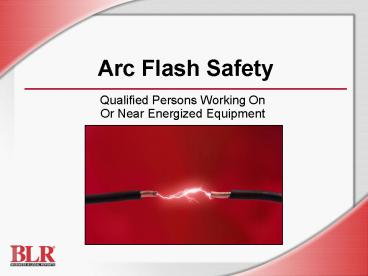Arc Flash Safety - PowerPoint PPT Presentation
1 / 26
Title:
Arc Flash Safety
Description:
Qualified Persons Working On Or Near Energized Equipment Objectives You will be able to: Identify the causes and risks of arc flash Implement safe work procedures ... – PowerPoint PPT presentation
Number of Views:1074
Avg rating:5.0/5.0
Title: Arc Flash Safety
1
Arc Flash Safety
- Qualified Persons Working On Or Near Energized
Equipment
2
Objectives
- You will be able to
- Identify the causes and risks of arc flash
- Implement safe work procedures
- Identify and wear appropriate PPE
- Respond to an arc flash
3
What Is an Arc Flash?
- Electrical short circuitor arcthrough the air
- Concentrated energy explodes outward
- High-intensity flash
- Instantaneous arc blast pressure wave
- Superheated ball of gasmelts metal, burns
clothes and skin
Image Credit OSHA
4
Arc Flash Effects
- Severe burns
- Fireball destroys skin and tissue
- Heat blast can extend several feet from source
- Burns from hot surfaces, projectiles, and fireball
- Hearing loss
- Extensive damage to equipment
- Punctures and lacerations
Image Credit OSHA
5
Causes of Arc Flash
- Dropped tools
- Accidental contact with electrical systems
- Improper work procedures
- Insulation failure
- Voltage testing with inappropriate instrument
- Inattentiveness
6
Causes of Arc Flash (cont.)
- Buildup of dust, impurities, and corrosion on
insulating surfaces - Sparks produced during racking of breakers,
replacement of fuses, and closing into faulted
lines - Birds or rodents that break leads at connections
7
Arc Flash Exposure Risk
- Workers are at higher risk when
- Exposed to energized parts often
- Required to perform multiple tasks
- Poorly trained
- Concentration is broken
8
Arc Flash Exposure Risk (cont.)
- Risk is lower when
- Clear work practices are established
- Training is thorough and up to date
- Proper PPE is worn
- Equipment is routinely maintained
- Workers are alert
9
ExerciseHazards and RisksList 4 arc flash
effects
Severe Burns
Hearing Loss
Excessive Damage to Equipment
Puncture Wounds and Lacerations
10
Exercise (cont.)List at least 3 causes of arc
flash
Dropped Tools
Accidental contact with electrical systems
Improper work procedures
Insulation failure
Voltage testing with inappropriate tool
Buildup of dust, impurities and corrosion
Sparks produced during maintenance
Birds or rodents that break connection leads
Worker Inattentiveness
11
Arc Flash HazardsAny Questions?
- Do you understand
- What an arc flash is?
- Effects of a flash?
- What can cause a flash?
- Your exposure risk?
12
Arc Flash Prevention
- Allow only qualified persons
- De-energize equipment whenever possible
- Create safe work conditions
- Use proper equipment
13
Safe Work on Energized Parts
- Never work on live equipment, except when
- De-energizing introduces additional or increased
hazards - It is not feasible to de-energize
- The proper training and safety equipment is
provided
14
Safe Work Practices
- 1. Review the operation
- 2. Determine the hazards
- 3. Determine and implement protective measures
- 4. Wear appropriate PPE
- 5. Know how to respond to an arc flash incident
15
Safe Work Practices Review the Operation
- Read all warning signs
- Read the hot work permit
- Match the tools to the operation
- Take whatever readings are necessary to quantify
the systems operation.
16
Safe Work Practices Determine the Hazards
- Identify and inspect energized parts
- Respect the flash protection boundary
- Identify sharp objects and other obstructions
- Identify all environmental hazards
17
Safe Work PracticesThe Flash Protection Boundary
- Limited approach boundary
- Restricted approach boundary
- Prohibited approach boundary
18
Safe Work Practices Deenergizing and Lockout
- Identify all possible sources of energy supply
- Open disconnecting device(s)
- Verify device is open
- Apply lockout/tagout devices
- Test voltagedouble check instrument rating
- Apply grounding devices
19
Safe Work Practices Wear Appropriate PPE
- Helmet or headgear
- Arc-rated face shield
- Safety glasses
- Rated gloves
- Rated shoes/boots
- Rated flame-resistant clothing
- No metal button, clasps, or zippers!
Credit Web Soft Safety Solutions
20
Explosion Response Procedure
- Turn off the power
- Extinguish flames
- Call for help
- Begin CPR and first aid, if trained
21
Take Other Precautions
- Only qualified persons
- Wear only nonconductive apparelno jewelry
- Work area must be illuminated
- No conductive liquids near electrical work or
equipment - Do not defeat electrical interlocks
- Double-check for the right tools
22
Safe Work PracticesAny Questions?
- Do you understand about
- Operations review?
- Hazard determination?
- Work practices?
- PPE?
- Emergency response?
23
Warning Labels
- Placed on all equipment with potential arc flash
hazard
Photo Credit MIDWEST
24
Reportand Dont Use Damaged Equipment
- Stop using and report
- Broken or missing covers
- Damaged tools
- Damaged equipment
- Improper equipment placement
Photo Credit OSHA
25
What are the 5 steps to safe work practices?
1
Review the operation Determine the
hazards Determine and implement protective
measures Wear appropriate PPE Know how
to respond to an arc flash incident
2
3
4
5
26
- Inspect equipment and work areas for arc flash
hazards and risks - Human error a common cause of arc flash
- De-energize whenever possible
- Follow safe work practices
- Wear all required PPE
- Reportand dont usedamaged equipment and tools































